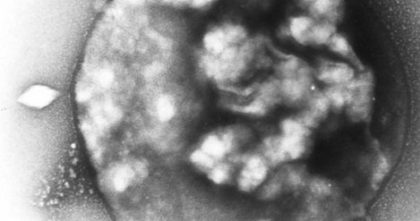
When I was a graduate student, I did a rotation in a tuberculosis lab. Mycobacterium tuberculosis and research strains grow very slowly; one round of cell division can take nearly a day. E. coli can divide every 20 minutes, meaning that in the time it takes to grow two M. tuberculosis from one, you can get ten trillion E. coli. Since my rotation was only a couple of months, I was given an E. coli research project. And M. tuberculosis is still among the relatively small proportion of bacterial species that we can actually grow in the lab at all. Given all of that, I have a lot of respect for the Japanese team that spent 12 years culturing organisms from a group called Lokiarchaea. Imagine being a grad student in that lab.
Previously, Lokiarchaea have lived up to their somewhat fanciful name. Gene sequencing has become so cheap, and the technology so reliable, that we have started sequencing environmental samples rather than waiting to isolate individual organisms. Samples of deep sea mud yielded interesting new genomes from archaea (single-celled prokaryotes like bacteria) with some genes similar to those that were previously only found in eukaryotes like us. Were these combinations of genes from an actual living creature, or did genes from multiple creatures get scrambled? Thanks to the patience of these scientists, we can see Lokiarchaea for ourselves and have greater confidence that all those genes actually belong together.
Why go to all that trouble to grow these archaea? We are curious where we came from. Eukaryotic cells like ours all have mitochondria, which look tinier cells inside of the bigger cells. We have good reason to think they look that way because they descended from free-living cells. Once, the population of the planet was just bacteria and archaea. Then a bacterium wound up inside an archaeon and the two managed to coexist in that arrangement. The outer archaeon cell gave rise to all eukaryotes while the bacterium gave rise to all their mitochondria. And based on their genes, these Lokiarchaea appear to be the closest living relative of that archaeon ancestor of all eukaryotes. That’s not to say we evolved from Lokiarchaea; they have also been evolving for the roughly two and a half billion years since the earliest eukaryotes appeared. But they can help us get a better sense of what that common ancestor would have been like. And they will also enable us to understand more about the present diversity of life, since they have significant differences from anything else we’ve studied so far. The shape of these archaea in particularly are intriguingly suggestive of endosymbiotic potential (endosymbiosis is the arrangement of mitochondria co-existing inside eukaryotic cells), although it will be a while longer before we know if that actually means anything with respect to eukaryotic origins.
Really, the whole story is about waiting. About one billion years passed from the emergence of the first life until the merger which brought together archaea and bacteria. Then another two billion years passed before multicellular animals came along. We don’t know what took so long. Some of the time may have simply been necessary to generate enough diversity for interesting combinations. Perhaps the algae had to complete certain steps in their terraforming project to create the appropriate conditions. We’ll have to wait longer to get a more complete picture. Still, I find it remarkable that we can learn anything about such deep past.
In case you missed it, check out the news about Bob Trube joining the Emerging Scholars Network team as director.
Andy has worn many hats in his life. He knows this is a dreadfully clichéd notion, but since it is also literally true he uses it anyway. Among his current metaphorical hats: husband of one wife, father of two teenagers, reader of science fiction and science fact, enthusiast of contemporary symphonic music, and chief science officer. Previous metaphorical hats include: comp bio postdoc, molecular biology grad student, InterVarsity chapter president (that one came with a literal hat), music store clerk, house painter, and mosquito trapper. Among his more unique literal hats: British bobby, captain’s hats (of varying levels of authenticity) of several specific vessels, a deerstalker from 221B Baker St, and a railroad engineer’s cap. His monthly Science in Review is drawn from his weekly Science Corner posts — Wednesdays, 8am (Eastern) on the Emerging Scholars Network Blog. His book Faith across the Multiverse is available from Hendrickson.

Leave a Reply